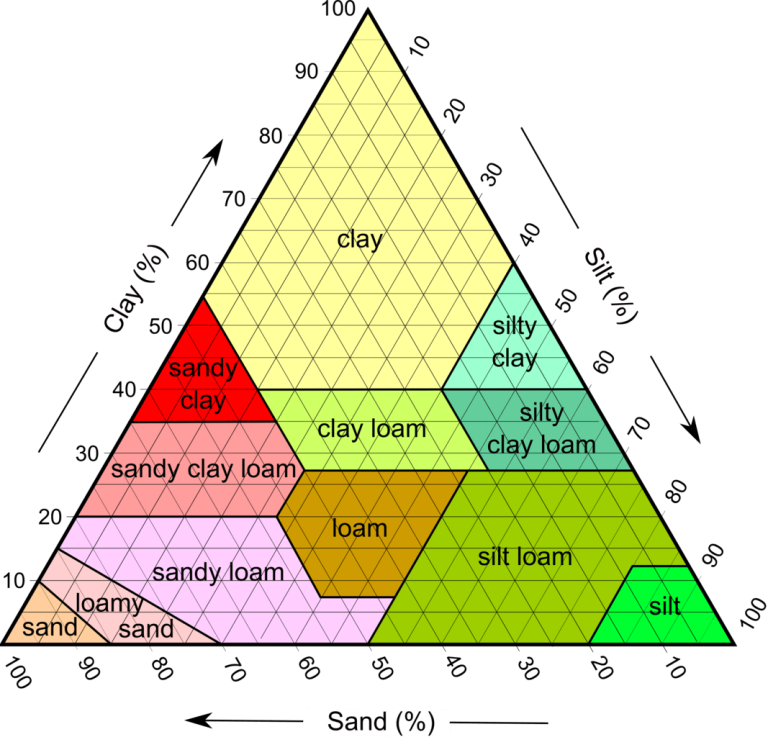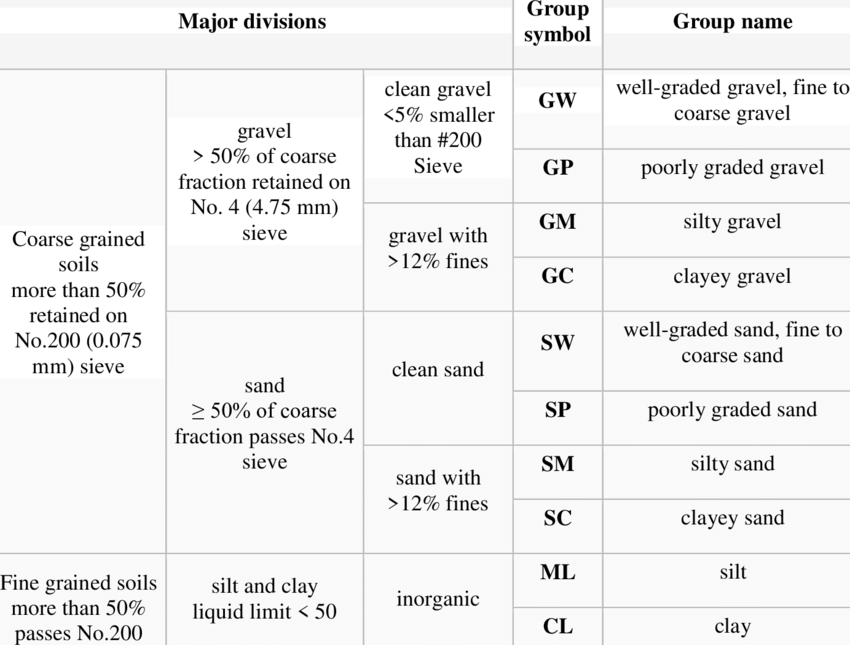Chapter:
1. Explain Field identification of soils.
Field identification of soils
Soils are generally divided on the basis of their particle size into coarse grained and fine-grained soils.
Coarse-grained soils are of particle size greater than 0.075 mm or 75 micron and particles smaller than this make up fine-grained soils.
Further coarse grains are divided into gravel and sand, and fine grains are divided into silt and clay sized.
To identify the type of soil in the field, first we try to distinguish the soil as coarse grained soil and fine grained soil and we can do so by simply looking at the soil.
If It contains more than 50% of visible particles then the soil is coarse grained soil and if the soil contains less than 50% of visible particles then the soil is fine grained soil. Thus, grain size itself may be adequate to distinguish between gravel and sand but silt and clay cannot be distinguished by this technique. Particles smaller than sand are microscopic and are either silt or clay. We need to perform a couple of tests to distinguish between them.
The procedures are given briefly hereunder.
i) Gravel from sand:
Individual soil particles larger than 4.75 mm and smaller than 80 mm are called gravel; soil particles ranging in size from 4.75 mm down to 0.075 mm are called sand. Field identification of sand and gravel should also include identification of mineralogical composition, if possible.
ii) Sand from silt:
Fine sand cannot be easily distinguished from silt by simple visual examination. Silt may look a little darker in colour. However, it is possible to differentiate the two by the dispersion test.
Dispersion Test
This test consists of pouring a spoonful of sample in a jar of water. If the material is sand, it will settle down in a minute or two, but if it is silt, it may take 15 minute to 1 hour. In both the cases, nothing may be left in the suspension ultimately.
iii) Silt from clay:
Microscopic examination of the particles is possible only in the laboratory. In the absence of one, a few simple tests are performed.
a) Shaking test (Dilatancy test)
In this test, a part of soil mixed with water to a very soft consistency is shaken after placing in the palm of the hand. If the soil is silt, water will rise quickly to the surface and give it a shiny glistening appearance.
If it is clay, the water cannot move easily and hence it continues to look dark. An estimate of relative proportions of silt and clay in an unknown soil mixture can be made by noting whether the reaction is rapid, slow or nonexistent.
b) Dry strength
The strength of a soil in a dry state is an indication of its cohesion and hence its nature. It can be estimated by crushing a 3 mm size dried fragment between thumb and forefinger. A clay fragment can be broken only with great effort, whereas a silt fragment crushes easily.
c) Rolling test (Toughness test)
A thread is attempted to be made out of a moist soil sample with a diameter of about 3 mm. If the material is silt, it is not possible to make such a thread without disintegration and crumbling. If it is clay, such a thread can be made even to a length of about 30 cm and supported by its own weight when held at ends.
d) Dispersion test
A spoonful of soil is poured in a jar of water. If it is silt, the particles will settle in about 15 minutes to one hour. If it is clay, it will form a suspension which will remain as such for hours, and even days, provided flocculation does not take place.
2. Explain Soil Classification.
Soil classification is the arrangement of soils into different groups such that the soils in a particular group have similar behaviour.
Soil can be classified on the following basics:
- Descriptive Classification of soil
- Texural classification
- ISI classification
- MIT classification system
- AASHTO classification system
- Unified soil classification system (USCS)
Descriptive Classification of Soil
1) Boulder, gravel & sand :
These are coarse grained soils and soil particles that belong to this category posses no cohesion among themselves. The main distinguishing physical feature among boulders, gravels and sands is the size of their particles. Boulders are larger than gravel particles. Gravels are larger than sand particles.
2) Silt:-
It is a fine grained soil and occurs in two varieties non-plastic varieties including rock flour and plastic varieties containing finely divided particles of organic matter.
3) Clay :-
Soil particles smaller than 0.002mm size and capable of showing plasticity when wet are called clays. The property of plasticity of clay is exhibited over a large
plasticity range of water content.
4) Peat :
It is a partly carbonized organic matter and is fibrous in nature.
5) Loess:
Fine grained yellow colored soil having cohesive nature. It is deposited by wind blow.
6) Hardpan:
Soil strata which remains hard when wet.
7) Bentonite:
It is volcanic ash which contains montmorillorite.
8) Top soil:
Disintegrated surface materials which supports plant & animals etc.
9) Mooram:
Mixture of iron, stone, gravels & red clay.
10) Laterite:
Soil having perforated & cellular structure.
11) Varved clay:
Alternate deposition of silt & clay.
12) Loam:
It is the mixture of sand, clay and silt.
Texural classification of Soil:
The classification of soil exclusively based on particle size and their percentage distribution is known as textural classification system. This system specifically names the soil depending on the percentage of sand, silt and clay.
It is also commonly referred to as the triangular classification of soil.
In this classification, first of all, the soil sample is sieved to determine the percentage of sand, silt, and clay-sized particles. Utilizing the obtained relative percentage, the triangular chart is filled.
This method of classification doesn’t reveal any properties of the soil other than grain-size distribution. Hence it is suitable for the grain size distribution of coarse-grained soil only.
MIT classification system:
Indian Standard Soil classification system(ISSCS or ISI)
Indian Standard Classification System (ISC) was adopted by Bureau of Indian Standards is in many respect similar to the Unified Soil Classification (USC) system. Soils are divided into three broad divisions:
- Coarse grained soils, when 50% or more of the total material by weight is retained on 75 micro IS sieve.
- For fine grained soils, when more than 50% of the total material passes through 75 micron IS sieve.
- If the soil is highly organic and contains a large percentage of organic matter and particles of decomposed vegetation, it is kept in a separate category marked as peat (Pt).
Unified Soil Classification System (USCS)
The USCS is a modified version of the soil classification system developed by A. Casagrande. In this system, coarse-grained soil is classified based on grain size distributions whereas, fine-grained soils are classified based on the plasticity of the soil. Soils are categorized into 4 major groups:
Coarse-grained soils:
Fine-grained soils
Organic soils
Peat
Coarse grained soils are those with more than 50% of the material larger than 0.075mm (sieve number 200) size. Coarse grained soils are further classified into gravels (G) and sands (S). The gravels and sands are further divided into four categories according to gradation, silt or clay content. Fine grained soils are those for which more than 50% of soil finer than 0.075 mm sieve size. They are divided into three sub-divisions as silt (M), clay (c), and organic salts and clays (O). based on their plasticity nature they are added with L, M and H symbol to indicate low plastic, medium plastic and high plastic respectively.
AASHTO Soil Classification System:
American Association of State Highway and Transportation Officials (AASHTO) classification system is useful for classifying soils for highways. This classification is based on both particle size ranges and plasticity characteristics. The system comprises seven groups of inorganic soils, A-1 to A-7 with 2 sub - groups in all. The system is based on the following three soil properties:
- particle size distribution,
- liquid limit and
- plasticity index.
A group index is introduced to further differentiate soils, containing appreciable fine grained materials. (Group index is not used to place a soil in a particular group; it is actually a means of rating the value of a soil as a sub-grade material within its own group. The higher the value of group index, the poorer is the quality of the material.)
Group index is given by the following equation: Group index (G.L)= 0.2a + 0.005ac + 0.01bd
where, a is that portion of percentage passing 75 micron size sieve, greater than 35 and not exceeding 75 expressed as whole number (0 to 40) = (F -35)
b is that portion of percentage passing 75µ size sieve, greater than 15 and not exceeding 35 expressed as whole number (0 to 40) = (F - 15)
c is that portion of the liquid limit greater than 40
d is that portion of the plasticity index greater than 10
F is the percent passing No. 200 sieve (0.0075 mm)
 Guest
Guest


